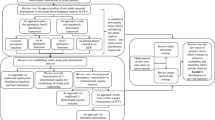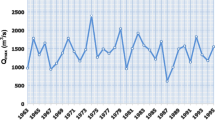Abstract
In confluence areas, where river flow slowdowns can be substantial, the selection of design flows for the purpose of designing a flood control system directly depends on flood waves at the mainstem and its tributaries. The aim of this paper is twofold: to elaborate a procedure that will define the flood exceedance probability in the analyzed area within a multidimensional probability space and to develop a methodology for defining flood coincidence in the mainstem reach with its main tributaries and thus determine design flows in order to design the flood control system in the confluence area. Mathematical models are based on (1) two-dimensional probability distribution (PROIL model) and (2) the copula function (Archimedean class of copulas), and fitted to a practical application in a two-dimensional probability distribution space. In case of random variables, simultaneous quantitative characteristics of flood wave (water flow) hydrographs for the mainstem and a tributary are considered. The paper discusses the specific reach of the Danube, from the Hungarian-Serbian border to the city of Smederevo, which encompasses three significant tributaries—the Drava, the Tisa, and the Sava.


















Similar content being viewed by others
Availability of Data and Material
Data and materials may be available on the request.
References
Bender, J., Wahl, T., Muller, A., & Jensen, J. (2016). A multivariate design framework for river confluences. Hydrological Sciences Journal, 61(3), 471–482.
Shiau, J. T. (2006). Fitting drought duration and severity with two-dimensional copulas. Water Resources Management, 20, 795–815. https://doi.org/10.1007/s11269-005-9008-9.
Wang, C. (2007). A joint probability approach for the confluence flood frequency analysis, Retrospective Theses and Dissertations, 14865. https://lib.dr.iastate.edu/rtd/14865.
Ashkar, F., & Aucoin, F. (2011). A broader look at bivariate distributions applicable in hydrology. Journal of Hydrology, 405(3–4), 451–461.
Linsley, K. R., Kohler, A. M., & Paulhus, L. H. J. (1975). Hydrology for Engineers. USA: McGrow - Hill Book Company Inc.
Marshall, A. W., & Olkin, I. (1988). Families of multivariate distributions. Journal of American Statistical Association, 83(403), 834–841.
Chebana, F., & Ouarda, T. B. M. J. (2011). Multivariate quantiles in hydrological frequency analysis. Envirometrics, 22(1), 63–78.
Krstanovic, P.F., & Singh, V.P. (1987). A multivariate stochastic flood analysis using entropy. In Hydrologic frequency modeling (pp. 515-539) . Springer, Dordrecht.
Yue, S., Ouarda, T. B. M. J., & Bobe’e, B., Legendre, P., Bruneau, P. . (1999). The Gumbel mixed model for flood frequency analysis. Journal of Hydrology, 226(1–2), 88–100.
Prohaska, S., & Ilic, A. (2010). Coincidence of Flood Flow of the Danube River and Its Tributaries. In M. Brilly (Ed.), Hydrological Processes of the Danube River Basin - Perspectives from the Danubian Countries (pp. 175-226). Springer, The Netherlands. https://doi.org/10.1007/978-90-481-3423-6_6.
Prohaska, S., Isailović, D., Srna, P., & Marčetić, I. (1999). The Danube and its Basin – A Hydrological Monograph Follow-up volume IV, Coincidence of Flood Flow of the Danube River and its Tributaries. In Regional Co-operation of the Danube Countries in the Frame of the International Hydrological Programme of UNESCO (pp. 1-187). Water Research Institute Bratislava, Slovakia.
Sackl, B., & Bergmann, H. (1987). A bivariate flood model and its application. Hydrologic frequency modeling. In V.P. Singh (Ed.), Dordrecht, the Netherlands: Dreidel, 571–582.
Yue, S. (2000). The bivariate lognormal distribution to model a multivariate flood episode. Hydrological Processes, 14(14), 2575–2588.
Yue, S. (2001). A bivariate gamma distribution for use in multivariate flood frequency analysis. Hydrological Processes, 15(6), 1033–1045.
Kotz, S., Balakrishnan, N., & Johnson, N. L. (2000). Continuous multivariate distributions. New York: John Wiley.
Nelsen, R. B. (2006). An introduction to copulas. New York: Springer.
Kao, S. C., & Govindaraju, R. S. (2010). A copula-based joint deficit index for droughts. Journal of Hydrology, 380, 121–134. https://doi.org/10.1016/j.jhydrol.2009.10.029.
Lee, T., Modarres, R., & Ouarda, T. (2013). Data-based analysis of bivariate copula tail dependence for drought duration and severity. Hydrological Processes, 27, 1454–1463. https://doi.org/10.1002/hyp.9233.
Reddy, M. J., & Ganguli, P. (2012a). Application of copulas for derivation of drought severity-duration frequency curves. Hydrological Processes, 26, 1672–1685. https://doi.org/10.1002/hyp.8287.
Wong, G., Van Lanen, H. A. J., & Torfs, P. (2013). Probabilistic analysis of hydrological drought characteristics using meteorological drought. Hydrological Sciences Journal-Journal Des Sciences Hydrologiques, 58, 253–270. https://doi.org/10.1080/02626667.2012.753147.
Balistrocchi, M., & Bacchi, B. (2011). Modelling the statistical dependence of rainfall event variables through copula functions. Hydrology and Earth System Sciences, 15, 1959–1977. https://doi.org/10.5194/hess-15-1959-2011.
De Michele, C., & Salvadori, G. (2003). A Generalized intensity-duration model of storm rainfall exploiting 2-copulas. Journal of Geophysical Research: Atmospheres, 108(D2), 4067. https://doi.org/10.1029/2002JD002534.
Ghosh, S. (2010). Modelling bivariate rainfall distribution and generating bivariate correlated rainfall data in neighboring meteorological subdivisions using copula. Hydrological Processes, 24, 35583567. https://doi.org/10.1002/hyp.7785.
Salvadori, G., & De Michele, C. (2007). On the use of copulas in hydrology: theory and practice. Journal of Hydrologic Engineering, 12(4), 369–380. https://doi.org/10.1061/(ASCE)1084-0699(2007)12:4(369).
Singh, V. P., & Zhang, L. (2007). IDF curves using the Frank Archimedean copula. Journal of Hydrologic Engineering, 12(651–662), 2019. https://doi.org/10.1061/(asce)1084-0699(2007)12:6(651).AccessedinJune.
Zhang, L., & Singh, V. P. (2007). Bivariate rainfall frequency distributions using Archimedean copulas. Journal of Hydrology, 332, 93–109. https://doi.org/10.1016/j.jhydrol.2006.06.033.
Bardossy A. (2006). Copula-based geostatistical models for groundwater quality parameters. Water Resources Research, 42. https://doi.org/10.1029/2005wr004754.
De Michele, C., Salvadori, G., Canossi, M., Petaccia, A., & Rosso, R. (2005). Bivariate statistical approach to check adequacy of dam spillway. Journal of Hydrologic Engineering, 10, 50–57. https://doi.org/10.1061/(asce)1084-0699(2005)10:1(50).
Bezak, N., Mikoš, M., & Šraj, M. (2014). Trivariate frequency analyses of peak discharge, hydrograph volume and suspended sediment concentration data using copulas. Water Resources Management, 28, 2195–2212. https://doi.org/10.1007/s11269-014-0606-2.
Favre, A. C., El Adlouni, S., Perreault, L., Thiemonge, N., & Bobee, B. (2004). Multivariate hydrological frequency analysis using copulas. Water Resources Research, 40, W01101. https://doi.org/10.1029/2003WR002456.
Genest, C., & Favre, A. C. (2007). Everything you always wanted to know about copula modeling but were afraid to ask. Journal of Hydrologic Engineering, 12(4), 347–368. https://doi.org/10.1061/(ASCE)1084-0699(2007)12:4(347).
Grimaldi, S., & Serinaldi, F. (2006). Asymmetric copula in multivariate flood frequency analysis. Advances in Water Resources, 29: 1155-1167. https://doi.org/10.1016/j.advwatres.2005.09.005.
Karmakar, S., & Simonovic, S. P. (2009). Bivariate flood frequency analysis. Part 2: a copula-based approach with mixed marginal distributions. Journal of Flood Risk Management, 2, 32–44. https://doi.org/10.1111/j.1753-318X.2009.01020.x.
Renard, B., & Lang, M. (2007). Use of a Gaussian copula for multivariate extreme value analysis: some case studies in hydrology. Advances in Water Resources, 30, 897–912. https://doi.org/10.1016/j.advwatres.2006.08.001.
Shiau, J. T., Wang, H. Y., & Tsai, C. T. (2006). Bivariate frequency analysis of floods using copulas. Journal of the American Water Resources Association (JAWRA), 42(6), 1549–1564.
Zhang, L., & Singh, V. P. (2006). Bivariate flood frequency analysis using the copula method. Journal of Hydrologic Engineering, 11, 150–164. https://doi.org/10.1061/(asce)1084-0699(2006)11:2(150).
Chen, L., Singh, V. P., Guo, S. L., Hao, Z. C., & Li, T. Y. (2012). Flood coincidence risk analysis using multivariate copula functions. Journal of Hydrologic Engineering, 17, 742–755. https://doi.org/10.1061/(asce)he.1943-5584.0000504.
Huang, K., Chen, L., Zhou, J., Zhang, J., & Singh, V. P. (2018). Flood hydrograph coincidence analysis for mainstem and its tributaries. Journal of Hydrology, 565, 341–353. https://doi.org/10.1016/j.hydrolo.2018.08.007.
Jhong, B. C., & Tung, C. P. (2018). Evaluating future joint probability of precipitation extremes with a copula-based assessing approach in climate change. Water Resources Management, 32(13), 4253–4274. https://doi.org/10.1007/s11269-018-2045-y.
Jhong, B. C., Huang, J., & Tung, C. P. (2019). Spatial assessment of climate risk for investigating climate adaptation strategies by evaluating spatial-temporal variability of extreme precipitation. Water Resources Management. https://doi.org/10.1007/s11269-019-02306-8.
Salvadori, G., DeMichele, C., Kottegoda, N.T., & Rosso, R. (2007). Extremes in nature: an approach using copulas, water science and technology library series.Vol.56, 1st ed., Springer, Dordrecht, The Netherlands.
Abramowitz, M., & Stegun, A. I. (1972). Handbook of mathematical functions with formulas, graphs and mathematical tables. New York: Dover Publications, INC.
Schmidt, T. (2006). Coping with Copulas. Forthcoming in Risk Books, Copulas- From Theory to Applications in Finance. Department of mathematics, University of Leipzig.
Dupuis, D. J. (2007). Using copulas in hydrology: benefits, cautions and issues. Journal of Hydrologic Engineering, 12(4), 381–393. https://doi.org/10.1061/(ASCE)1084-0699(2007)12:4(381).
Reddy, M. J., & Ganguli, P. (2012b). bivariate flood frequency analysis of Upper Godavari River flows using Archimedean copulas. Water Resources Management, 26(14), 3995–4018. https://doi.org/10.1007/s11269-012-0124-z.
Genest, C., Remillard, B., & Beaudoin, D. (2009). Goodness-of-fit tests for copulas: A review and a power study. Insurance: Mathematics & Economics, 44, 199-213.
Markiewicz, I., Strupczewski, W. G., & Kochanek, K. (2010). On accuracy of upper quantiles estimation. Hydrology and Earth System Sciences, 14, 2167–2175. www.hydrol-earth-syst-sci.net/14/2167/2010/. https://doi.org/10.5194/hess-14-2167-2010.
Acknowledgments
The authors express their gratitude to the Ministry of Education, Science and Technological Development of the Republic of Serbia for its financial assistance and support.
Funding
The presented analyses and results are part of the outcomes of the research project “Assessment of Climate Change Impact on Serbia’s Water Resources” (TR-37005), 2011–2019, of the Ministry of Education, Science and Technological Development of the Republic of Serbia.
Author information
Authors and Affiliations
Contributions
Aleksandra Ilić designed the initial research, conducted research and wrote initial manuscript except Introduction chapter. Stevan Prohaska checked the statistical analysis and results. Dragan Radivojević presented the results graphically. Slavisa Trajković contributed in terms of improving the initial research, writing Introduction chapter, improving the written language of the manuscript and checking the overall logical flow of the manuscript. In addition, the authors pointed out necessary comments towards improving the quality of the final manuscript.
Corresponding author
Ethics declarations
Conflict of Interest
The authors declare that they have no conflict of interest.
Additional information
Publisher’s Note
Springer Nature remains neutral with regard to jurisdictional claims in published maps and institutional affiliations.
Appendices
Appendix 1. Marginal Probabilities Q 1%
Appendix 2. Copula Properties
See Table 8.
Rights and permissions
About this article
Cite this article
Ilić, A., Prohaska, S., Radivojević, D. et al. Multidimensional Approaches to Calculation of Design Floods at Confluences—PROIL Model and Copulas. Environ Model Assess 26, 565–579 (2021). https://doi.org/10.1007/s10666-021-09748-8
Received:
Accepted:
Published:
Issue Date:
DOI: https://doi.org/10.1007/s10666-021-09748-8




